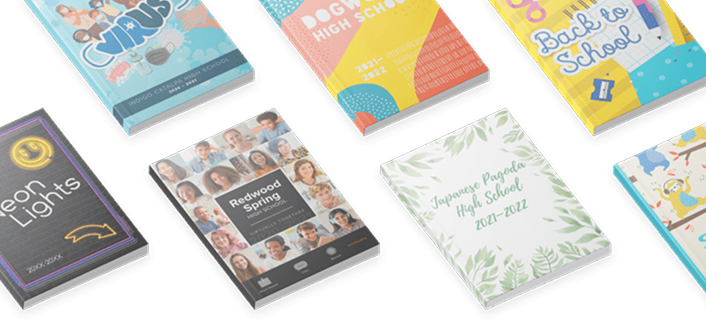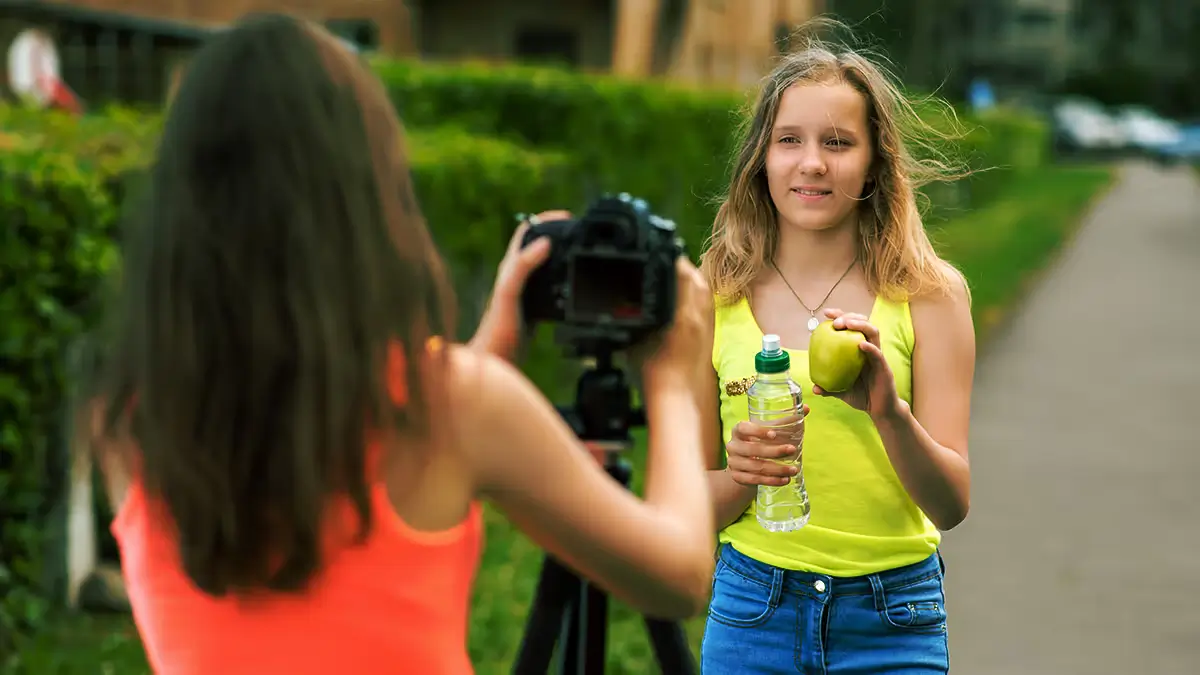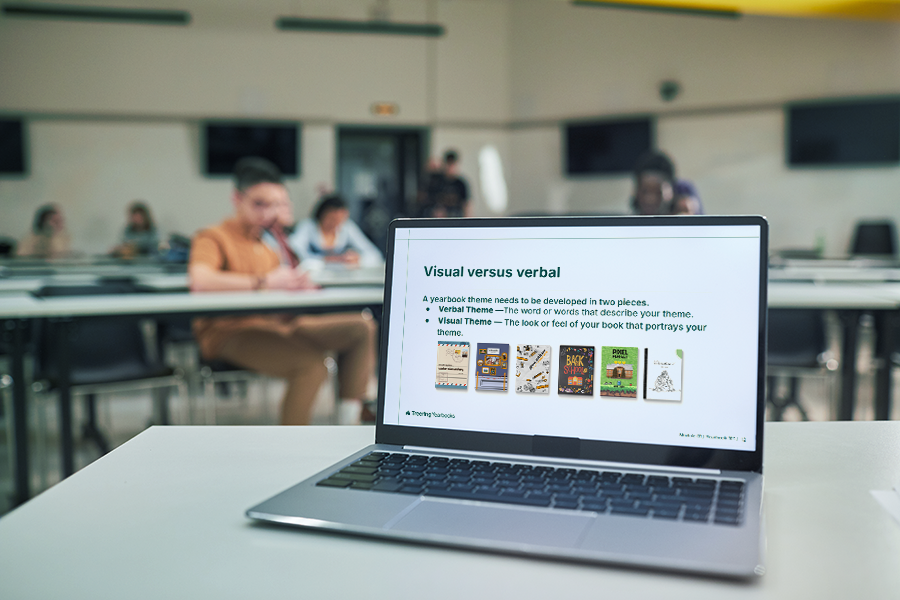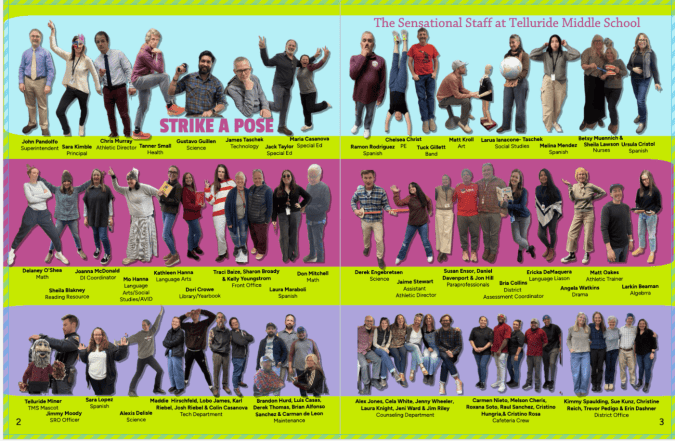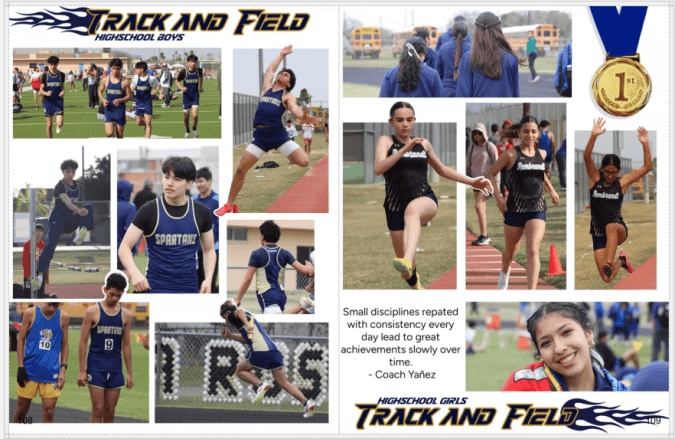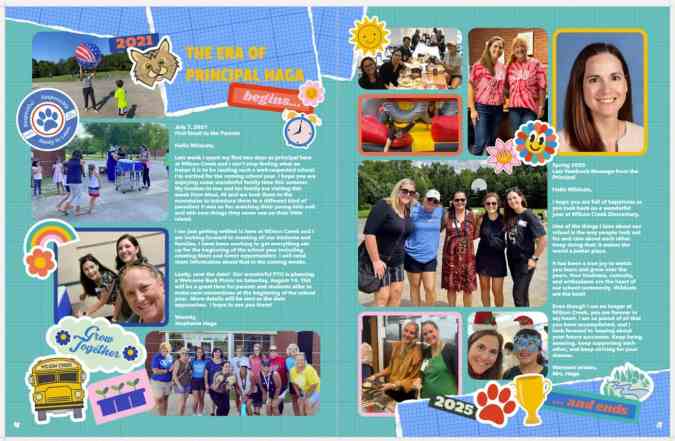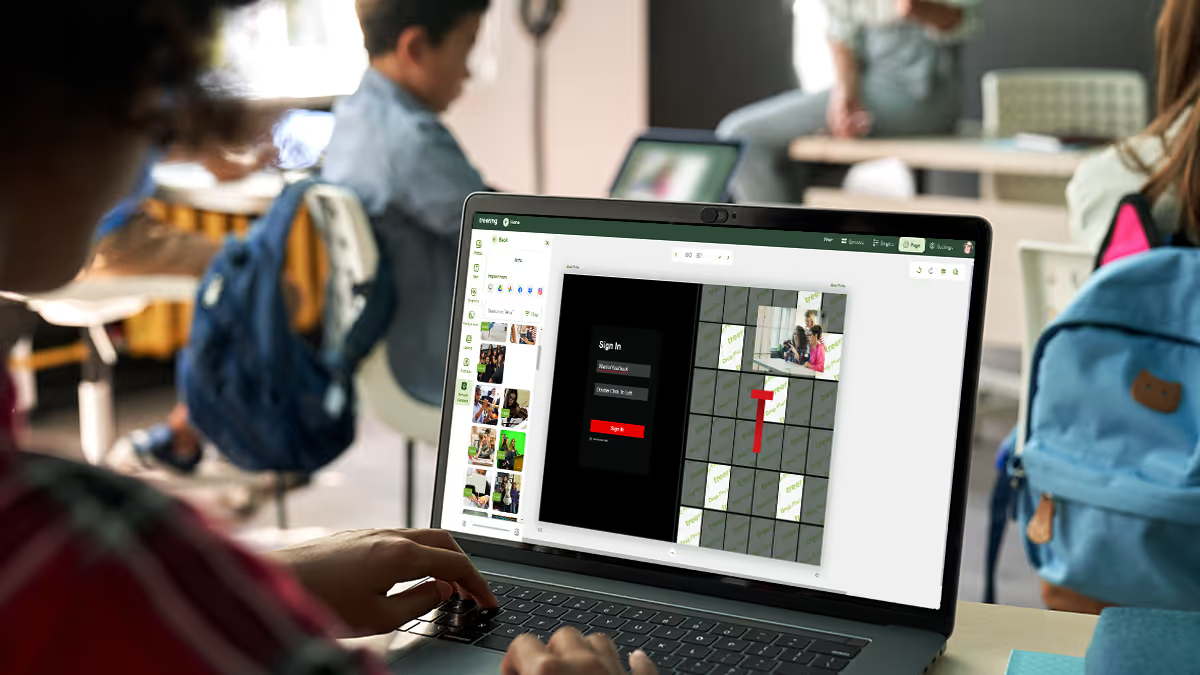Most popular
Subscribe to our blog
Most recent

Scrapbook yearbook themes
Scrapbooks are deeply personal and emotionally charged. They’re where Millennial moms stash ticket stubs, scribbled notes, and snapshots. Students also lean towards the collage aesthetic via pop culture inspiration—like the Burn Book in “Mean Girls” or My Adventure Book in “Up.”
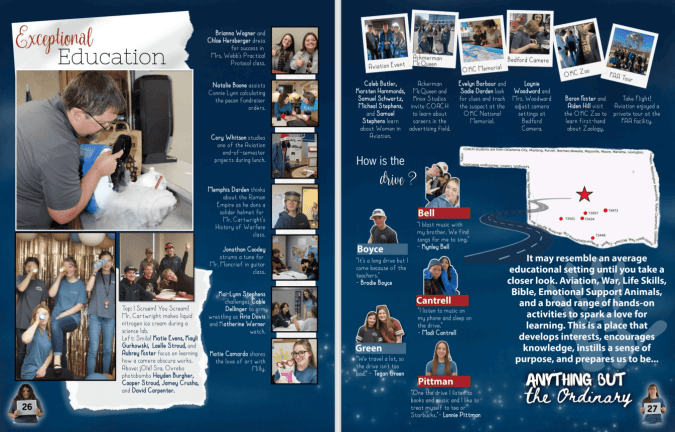
While the Burn Book itself is not the kind of sentiment you want to capture in a school yearbook, its visual style has inspired many scrapbook-themed designs: magazine cutout lettering, sticker overload, and chaos-meets-craft aesthetic speak to the way students envision personal memory books.
Likewise, Carl and Ellie’s book is a love letter to scrapbooking itself. It balances whimsy, sincerity, and nostalgia. (We’re not crying. OK, maybe a little.)
Three free Treering themes to get the scrapbook vibe
One of the best parts of the scrapbook yearbook theme is its flexibility. You can up the visual intensity depending on your staff’s skill level and your community’s taste. We have three complete yearbook themes that model scrapbook yearbooks.
Because a scrapbook style mimics personal journaling, students feel connected. It looks like their notes, their lockers, and, to an extent, their social feeds. The collage-inspired layouts also let you pack in more visual content, perfect for schools that crowdsource images from parents, staff, and students.
“Crafted” - intro to the DIY aesthetic
The 75 pre-designed templates have built-in white space and subtle borders, which gives a clean scrapbook look. The 64 graphics, which include a variety of torn papers and tapes, allow teams to add variety and rough edges. This look works well for journalistic high school books that want polish with personality.

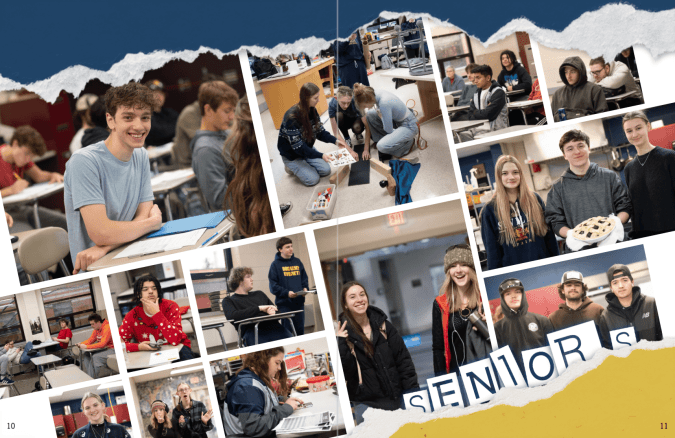
“Collage” - scrapbooking to the max(imalist)
Lean into creative chaos with 862(!) design elements. This theme mimics a real-life scrapbook packed with overlapping images, ripped notebook paper, buttons, stickers, and magazine-style clippings. Because it is a maximalist look, you can create unity among the varied elements by

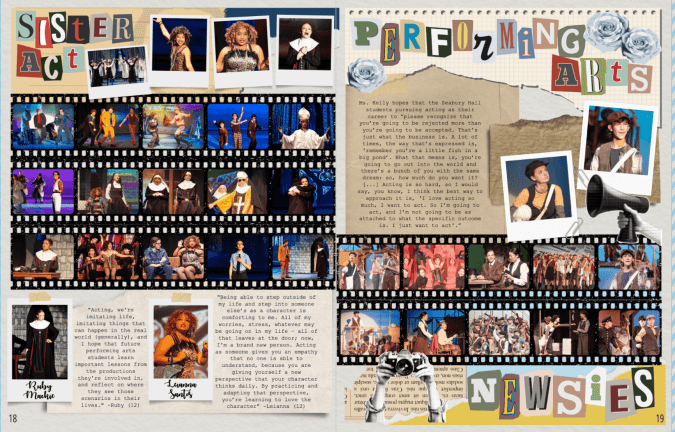
“Venture” - the vintage journal
Inspired by antique books, this yearbook theme includes 100 aged paper backgrounds plus 616 graphics including typewriter keys, delicate handwritten fonts, antique elements, and photo corners. The textures and photorealistic elements work well in layers with a handwritten or type-writer font. Like the maximalist approach above, remember the rules of design to keep it from looking cluttered.


A scrapbook yearbook theme works at any level, elementary, middle, or high school. It can look rustic and handmade. Retro and analog. Colorful and chaotic. Minimalist and soft. The best part? It doesn’t lock you into a single aesthetic—it's more of a concept than a rulebook.

The forgotten art of making students smile: how one family's philosophy outlasted 75 years of technological revolution
Editor's Note: Welcome to the inaugural profile in our special "Picture Perfect Partnerships" feature series. We'll spotlight the remarkable photographers who partner with us to create lasting memories for schools nationwide. Our first profile celebrates Van Gogh School Photographers, a family business that has captured student smiles in the Chicagoland area for over 75 years. We talked to President Jack Zucco (pictured above with son Michael) about his family’s legacy.
How did your family's school photography business begin, and what inspired your father's initial entry into this specialized field?
Van Gogh School Photographers was founded in 1947 by my father. He believed every student deserved a well-crafted, lasting memory of their school years. With a passion for photography and a commitment to excellent service, he set out to build a business that not only took pictures but also preserved cherished moments for families and schools alike.
What were the most significant challenges your family faced when establishing the business in 1947, and how did they overcome them?
Resources were limited, technology was far less advanced, and building a customer base from scratch was no small feat. My father had to earn the trust of schools one by one, going door-to-door to demonstrate the value of professional school photography. He overcame these hurdles by staying true to his core principles—offering reliable service, consistent quality, and a personal touch that set Van Gogh apart.
How has the business been passed down through the generations, and what traditions or values have remained consistent?
Each generation has brought new ideas and innovations, but the fundamental values—quality, professionalism, and a customer-first approach—have remained constant. Barrington, IL has been our headquarters for almost 50 years.
What significant changes or pivotal moments shaped your family business's evolution across three generations?
There have been several defining moments in our history. The transition from film to digital photography was a major shift, requiring new equipment, training, and processes. Another pivotal moment was expanding our services beyond just portraits to include yearbooks. Our 12-year partnership with Treering has been one of the most significant milestones, allowing schools to create personalized, on-demand yearbooks that give students and families a more meaningful way to preserve memories.
How have you personally contributed to or innovated within the family legacy since joining the business?
Since joining the business, I've focused on modernizing our operations, refining our photography process, and improving efficiency without sacrificing quality. I've also played a key role in expanding our yearbook services through our partnership with Treering.
Can you share a particularly meaningful school photography project that spans multiple generations of your family's work?
One of the most meaningful aspects has been capturing school portraits for multiple generations within the same families. There have been instances where we photographed a student and years later took their children's and even their grandchildren's school portraits. Seeing those families return to us decade after decade is incredibly rewarding.
How has your family maintained relationships with schools across generations, and what's been key to that longevity?
Our relationships with schools are built on trust, reliability, and a commitment to exceeding expectations. We don't just see ourselves as photographers—we are partners in helping schools create lasting memories. Personalized service, a 100% satisfaction guarantee, and our ability to adapt to schools' changing needs have been key factors in maintaining long-term partnerships.
What photography techniques or business practices have remained unchanged since your father's era?
While technology has evolved dramatically, core photography principles have remained unchanged. Proper lighting, professional posing, and attention to detail were as important in my father's time as today. The emphasis on customer service, reliability, and delivering a quality product has been constant throughout the decades. My father always believed in making sure every student left picture day feeling good about their experience—that philosophy still drives us today.

These yearbook photo tips will have your book looking better in two minutes or less
The easiest way to improve your yearbook photography is to spend two minutes editing your photos before you add them to your book. That’s because, in two minutes, you can make the two biggest improvements to any photo you have: composition and white balance.
It doesn’t matter if you or your staff purposely took the photo for use in the yearbook or if a parent snapped a shot on their phone and only gave it to you once you asked for help filling your book’s pages. If you spend one minute on each of these areas of improvement, you’ll have a yearbook photo that’s way, way better than the one you started with. We guarantee it.
In this blog post, we’ll walk you through why you should spend two minutes using these yearbook photo tips for composition and white balance, what you should think about before you make any changes, and how you can easily make those edits.
Why you should edit using these yearbook photo tips
The normal process for editing yearbook photos can be a total drain on your time. The results are worth it, because, well, let’s face it: not-so-great yearbook photography makes a yearbook seem not so great.
Great photos, on the other hand, can evoke emotion, tell a story, and captivate an audience—all at the same time. And sometimes, a photo needs a bit of editing to get there. Cropping your photos for better composition can eliminate distractions and correcting the color to improve white balance and lighting can help your photos stand out more.
Spend enough hours eking every last ounce of potential out of a photo, though, and you’re bound to wonder whether it’s all worth it.
If that’s you, or if you’re totally pressed for time, you never need to get to that point.
That’s because two of the quickest, easiest editing techniques you can use will get your photo more than 90% of the way to its full potential.
If you want to keep going for that final 10%, go right ahead.
But if you’re pressed for time or stressed about deadlines, crop your photo to improve its composition, use color correction to improve white balance, and move on to your next photo. Because, when you have hundreds of photos you want to add to your yearbook, 90% of full potential is pretty darn good.
What to think about before using our yearbook photo tips
Just using our two yearbook photo tips will give you great photos and save you a bunch of time. But you can always save more.
The trick lies in the old “work smarter, not harder” saying.
Here’s what you need to think about to save yourself even more time and sanity during your photo editing process:
- If your yearbook publishing software lets you crop your photos after you’ve added them to your pages, wait until then to take that step. Doing so will increase your flexibility when it comes to adjusting layouts on the fly.
- Start with an idea of how many photos you need for your book. This sounds daunting, but 1) it’s not, and 2) it’s super helpful to pre-plan and know what you need to make your pages awesome. If you’re using templates or master pages, this is a total breeze.
- Review the photos you have and start making two lists: likely to use, not likely to use. How you make these depends on how you organize your photos, but here’s one way that works for just about every scenario: Rename all “likely to use” photos with “a_” at the beginning of the file name and all “not likely to use” photos with “b_” at the beginning. That way, everything’s clearly labeled and, if you sort by name, your best photos show up first.
- Edit your “likely to use” photos. If you’ve got enough, your work is done. Sweet, right? If you’re still short some yearbook photos, you can go back through and find the best of the “not likely to use” photos or start hassling your school community to send you great photos.
If you’re cropping your photos before adding them to yearbook pages, you’ll also want to keep this in mind: You’ll need a variety of photo constraints and orientations.
Which is a perfect transition to…
Yearbook photo tip #1: composition
We’ve talked before about the three tips you should keep in mind when composing yearbook photos, but that doesn’t guarantee you’re always going to nail them. Or that people who are giving you pictures will, either.
Sometimes, the only way to save a yearbook photo is to crop it.
Take this before-and-after as an example:
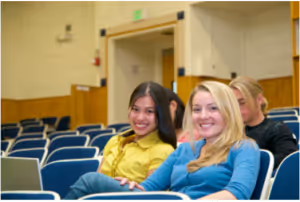

There’s a lot of good stuff going on with the photo on the top: It’s well lit, the students’ faces are clear, and it’s easy to identify where they are.
The problem?
It’s the same one that haunts many yearbook photos: Drop it into a spread or collage and it’s not exactly going to be easy to identify these students. They were too far away from the camera when the photo was taken, and there’s just too much empty space around them.
You can solve that by tightening the composition. Notice how much more the two students fill the frame in the photo on the right?
That’s exactly what we’re going for.
When you’re cropping yearbook photos, keep these two tips in mind:
- Fill the Frame. What matters most in a yearbook photo is capturing the person or people who are the subjects. Make sure to keep the attention on them. As a photographer, the best way to do that is to get very, very close to your subject. If that didn’t happen, though, you can crop out the empty space surrounding your subjects.
- Use the Rule of Thirds. If the “rule of thirds” is a new yearbook term to you, it’s basically a guideline in photography that encourages a photographer to move the primary subject of the photograph away from the center. The easiest way to do this is to use a grid overlay function while cropping, and move your subject to one of the intersecting set of lines.
Of course, we’d be slacking in our advice if we didn’t mention that, no matter what, you should be cropping with a purpose. Or if you want to frame this advice slightly differently: Don’t crop for the sake of cropping. The new constraints for your photo should make your photo better or make your page layout better. If your photos are already great, and they look great in your layout, you can skip cropping.
Yearbook photo tip #2: white balance
Ever feel like your photos don’t really look like the breath-taking scenes you saw with your naked eye? We feel you.
Outside of cropping your photo, the easiest way to restore some of that magic is to make the colors of your yearbook photo more vivid and more lifelike. And you can do that by using the levels tool in your editing software.
To do that, though, you need to know some basics about that tool and histograms, the chart associated with it.
Here’s the crash course version:
A histogram is a graphical representation of your photo’s color distribution. The dark aspects of your photo are plotted on the left of the graph; the light aspects of the photo are plotted on the right. When you’re reading a histogram, you want to look for sharp peaks at either end of the scale. A sharp peak on the left side of the graph indicates underexposure, a peak on the right indicates overexposure.
When you’re looking to tweak the color composition of your photo, it’s those peaks you want to be looking for.
Here’s the quickest — and easiest — way to use a histogram to improve your photo’s color:
- Drag your black slider (located on the left of the histogram) to the right until the chart shows blacks being registered (or the beginning first upward slope).
- Then drag your white slider (located on the right of the histogram) to the left, until the chart shows no more whites being registered (or the end of the last downward slope).
These two steps take about a minute to complete, and the result is awesome. You’ll see an improvement in contrast, richer and deeper colors, and an enhanced lightness that reveals hidden aspects of photos that are obscured by overly bright areas.
Here’s an example:


Notice how the red in the stairs and the fire extinguisher really pops in the one on the bottom? It’s less muted and, since the reds are deeper, it makes the person on the stairs stand out more, as well. We dig this change.
And really, that’s it.
It doesn’t matter who takes the photos. If you can spare two minutes and follow these yearbook photo tips, you can make your photos so much better by improving composition and white balance.
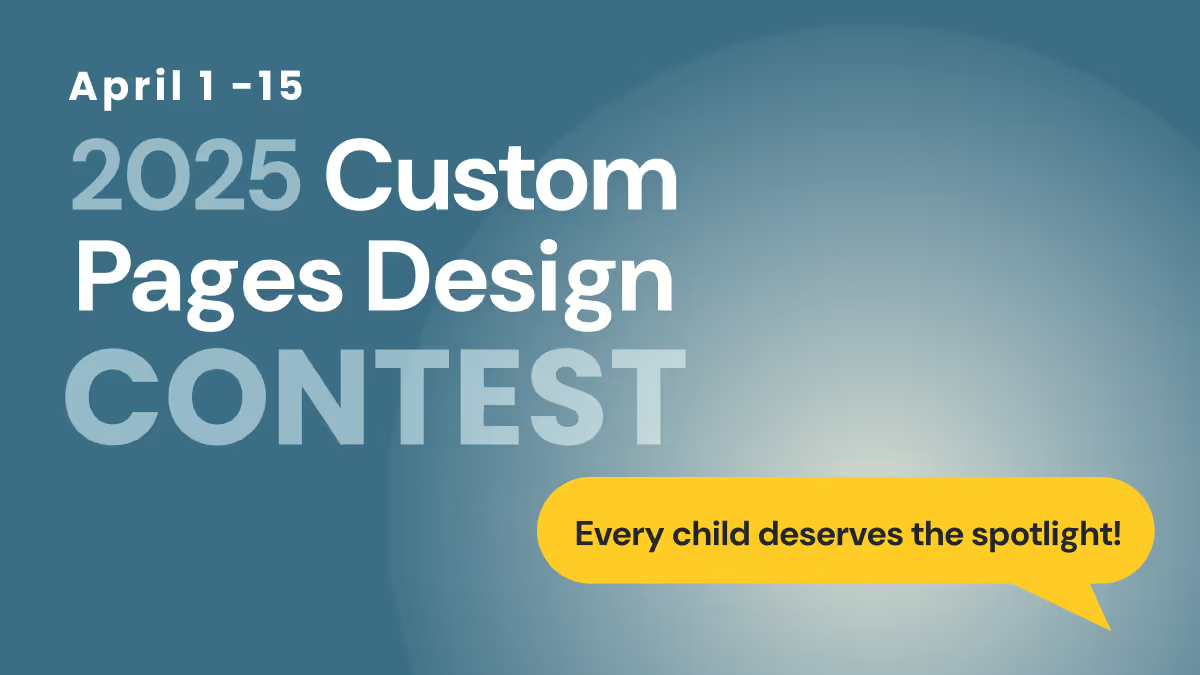
2025 custom page design contest
Your Kid. Your Design. Their Spotlight. Whether they’re sports MVPs, creative geniuses, or the kindest hearts around—we want to see it all! Share your Treering custom pages for a chance to win.
Entry Period
The submission period is April 1-15, 2025. Submissions will close at 11:59 PM PDT.
Eligibility
Entrants must be 18 years or older and current members of a US Treering school for the 2024-2025 school year.
To participate, complete the submission form and include a screenshot of your favorite yearbook spread. A yearbook spread is two-facing pages. Incomplete entries will not be accepted.
Winner Selection and Notification
A panel of yearbook parents, journalism educators, and graphic designers will select the winners. Judging criteria include visual interest and originality.
We will notify all the winners via email and phone on Monday, April 22, 2025.
Prizes
One Grand Prize winner will receive a $500 Amazon gift card, and ten Runners Up will each receive a $50 Amazon gift card.

By Friday, May 2, winners will receive gift cards via the email provided in the form.
Release
By submitting your custom pages, you have verified the approval of others pictured, and you approve Treering to use your name, write-up, and school name for any marketing purposes, including but not limited to treering.com, social media, and mass media.
Contest FAQs
What are Treering's custom pages?
Treering’s custom pages are two pages that each family may choose to design. These two pages are printed only in their copy, and no one else's, making every yearbook unique.
Do I have to have social media to enter?
You do not need social media to enter our annual design contest. Simply upload a screenshot of your favorite spread from your computer or phone on the entry form.
Do I have to purchase a yearbook to enter?
No purchase is necessary to enter.
Where can I see past spread design contest winners for inspiration?
I already finished my pages. Can I still enter?
Any pages you created for the 2024-2025 school year are eligible.
I have a question that is unanswered here. Who do I ask?
We'll be happy to answer. Email marketing@treering.com

Three yearbook colophon ideas
What is a colophon anyway? Publishers include this vital piece to record production notes and sometimes acknowledgments. Since your yearbook is a historical document, including a colophon adds professionalism to your publication. But it doesn’t have to be boring! Below are three examples of yearbook colophons that include theme details, shout-outs, and yearbook staffing information.
Essential components for your yearbook colophon
- Title of yearbook and theme information: include any behind the design information
- Book details: the number of pages, cover type, and paper weight
- Design specs: font names sizes and use cases
- Photography credits: Identify your portrait photographer, staff photographers, and any volunteer super parents who contributed
- Software tools: list which applications you used to build your book
- Publisher information: name of the publisher and the names of the publishing staff who helped
Thematic colophons


Both of these colophons leverage their themes (Stay Gold and Speak Life, respectively) with the headlines as well as the graphics. (The actual copy of their colophons is below for you to use.)
A bold colophon

We love this one because it features the yearbook team, gives the book details in an easy-to-read format, and both editors have space to say thank you.
Yearbook colophon template
To create a quick colophon, copy and paste the following in your yearbook. Make it your own by giving behind-the-design details.
[Yearbook name] is produced by [School Name] in [City, State] and published by Treering Yearbooks in San Mateo, CA. The [hard- and/or softcover] yearbooks are [matte or glossy] finish [with upgraded embossing or foil]. The book's [number] pages are printed in full color on 100lb. sustainably sourced paper—the Treering standard. We used the Treering app for the layouts; [if applicable, list software used to make photo illustrations]. The theme art is [theme name from Treering] and [name] designed the cover. Headlines are [font and size] with subheadings in [font and size]. Body copy is [font and size]. [Photographer] took the school portraits and [parents, coaches, non-yearbook students] contributed [team, event, and/or candid] photos.

Why camera aperture is critical to taking good yearbook photos
If you’re a shutterbug like me, you’re always after the perfect yearbook photo. But perfect shots are relative to the elements and subjects we’re aiming at. If it’s a picturesque landscape in Yosemite National Park, we’ll want Bridalveil falls and all surrounding elements in focus. If it’s a ladybug perched on the petal of a yellow daisy, this time, we’ll want to draw the viewers attention to the insect’s red shape. And, like most yearbook photos, if it’s of a group of students, we’ll want to make sure all of their smiling faces are crisp and clear. When it comes to achieving these goals you’ll need to master depth of field. And you can only do it through use of your camera’s aperture.
What is the aperture?
Simply put, the aperture is the physical opening in the lens that allows light to pass through. The wider the aperture opens, the more light can pass through. Want to know how to take yearbook photos, and for that matter, great ones? Master the aperture.
F-stops
Cameras measure their aperture settings in what are called f-stops, written f/1.4, f/8 and so on. You can typically find the maximum aperture marked on the lens itself. What’s important to remember, is that a camera’s f-stop setting shares an inverse relationship with the the width of the aperture opening. Huh? In a dark room, with low lighting, by setting your camera to f/2.8 or smaller, you’ll be creating a very wide aperture opening, thus letting a lot of light in. A smaller f-stop number equals larger aperture opening. Remember this inverse relationships as I’ll refer to f-stop numbers for the rest of the post.
Large f-stop numbers
There is something else that happens by using different f-stops, and sometimes with dramatic effects. Depth of field. In the image below, the f-stop is set at f/8. Some professionals call this the “sweet spot” because it is the aperture setting that provides the sharpest focus for a lens. Notice how all of the elements of the photograph are in focus?
Small f-Stop numbers
Now, let’s take it to the extreme by setting the camera on a wide open aperture setting (remember this means a small f-stop number). The photo below was taken by a lens with a maximum aperture setting of f/1.4. Notice how the baby’s eye is practically the only thing in focus, and that even her ear begins to “vanish”. This can create moody and dramatic effects with your photographs, especially for portraits or single elements.

Depth of field and the aesthetic quality of the blurred portions of photographs is such an important part of photography, that the Japanese have turned it into an art. They call it boke. Boke (BOH – KAY) focuses on the parts of a photograph that are not in the current plane of focus. We see these areas as blurry or hazy in the final work. The following photograph illustrates the beauty of Boke. Notice how the background almost appears to be painted due to its smooth texture?

3 tips for using aperture in your yearbook photos
Let’s cover a few technical applications of depth of field depending on the subject matter in your yearbook photos.
Portraits
Yearbook portraits are probably one of the most common yearbook photos your school will capture. You’ll want to follow some key rules of composition, being certain that you are filling the frame with faces, but you’ll also want to make sure that the critical element of the photograph is in focus: The face. When taking portraits of one person, you’ll have a lot of flexibility in choosing your aperture setting. Be sure to focus on the subject’s eyes when using a low f-stop number (f/5.6 or lower).

Yearbook setting shots
When taking photographs of the school grounds and building, or of events and activities with large gatherings of people, be sure to use an f-stop setting of f/8 – f/11. This will ensure that the focus of all the elements in the photograph are sharp.

Yearbook group photos
The great documentary photographer, Arthur Fellig, when asked how he was able to capture critical moments of rapidly changing events, simply replied “f/8 and be there.” When taking group photos, you’ll also want to use an f-stop number of f/8 or larger. That way, the faces of all of your subjects will be sharp. This will also allow you to focus on your composition.

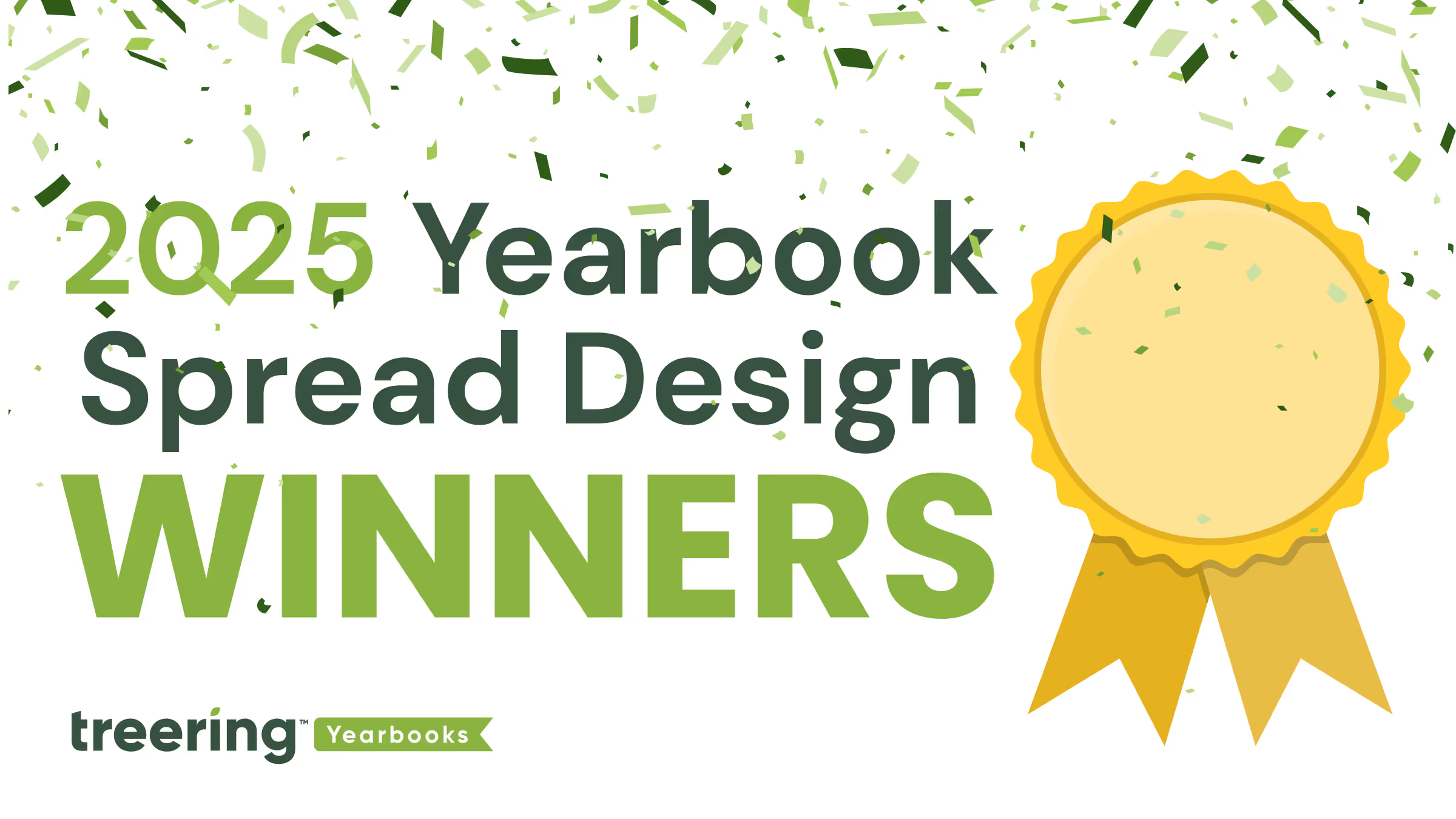
Winners of the 2025 spread design contest
We asked you to “show us what you got” and you understood the assignment. The diversity of subjects—portrait, divider, baby photo, staff, senior tributes, superlatives, arts, and athletics spreads—coupled with the styles, themes, and narratives left us inspired.
Thank you.
It sounds cliche to say it was tough to comb through hundreds of submissions, read your stories, and examine everything from how photos were cropped to how they balanced across the spread. But you delivered quite the challenge.
A panel of yearbook and design professionals, PTA parents, and journalists looked through every submission in a blind judging. They evaluated your submissions on
- Layout design
- Storytelling
- Visual elements and their relevance to content
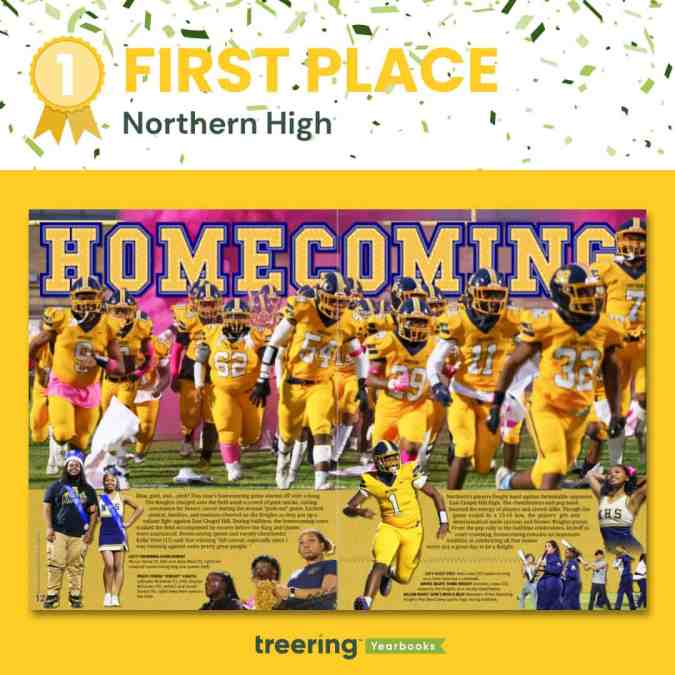
Grand Prize Winner: Northern High School, Durham, NC
Remember those prom dress-I’ll-know-when-I-see-it vibes? That was our impression of Northern High’s homecoming spread. It was unanimous. As soon as the panel saw this spread, “This is it.”
The “Polaris” staff at Northern High earned ten free yearbooks, a $500 Amazon gift card, and a $200 pizza party to enjoy as a staff.
“Our goal is twofold: To show that we are all part of our school community and school culture and to illustrate that there's more to us than meets the eye,” junior Nourriah Scott said.
Their yearbook theme, “All 'N' the Details," is both traditional (check out the classic typography) while adding modern design elements. Their theme goes beyond the visual and uses the narrative to showcase all aspects of an event.
“As the viewer travels through the spread,” Scott said, “they learn there's more to it: the court, the cheerleaders, the band, the crowd. Homecoming is just a single event in the course of an entire school year, and look how many people and parts of our school are involved in making it magical.”
Why we Loved this Design:
The details emerge once you get beyond the wow factor from the colors. Homecoming is written in a font similar to a letterman’s jacket and, as the main entry point to the spread, is behind the football team. This is a student-first design.
Additionally, the use of COB (cut-out background) photos enhances the design. The yearbook team positioned the sharp edge in the gutter and used a gradient to fade out the other.
Design hierarchy also played a key role. The story crosses both pages, bolded ledes give the reader even more entry points, and candid photos highlight all the participant groups. They indeed are “All ‘N.”
Bonus: As a Title I school, the “Polaris” staff does not have access to Adobe or other paid design tools. They created their winning spread using the Treering yearbook builder and free, web-based photo editing tools.
Runners Up
For hours, we had a solid 26 spreads on display and our panel highlighted the merits of each. When we returned to the original judging criteria, five emerged. In alphabetical order by school name, the following schools each earned three free yearbooks and a $50 Amazon gift card.
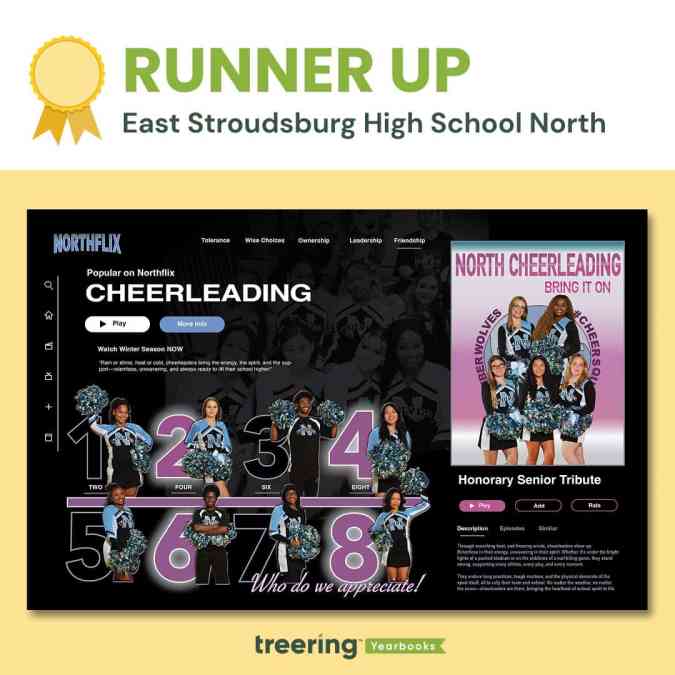
Finalist: East Stroudsburg High School North, Dingmans Ferry, PA
While this isn't the first time we've seen a streaming media look, it is one of the best iterations. The team at ESHSN used the cheer individual photos to create a movie poster on the right and recapped the season as the program description.
Across the top are the TWOLF values “intended to promote the application of knowledge, develop healthy identities and decision-making skills, achieve goals, manage emotions, show empathy, and establish healthy relationships,” Adviser Keisha Agard-Thomassine said.
Why we Loved this Design
One word: color. The school color is front and center in a spread centered around the spirit-makers. Timberwolf blue is used on the yearbook logo and as a button. The analogous purple makes it pop further.
“We beam with pride over here,” Agard-Thomassine said.
The subtle detail of the group photo in the background adds another layer of complexity to a bold and balanced spread.
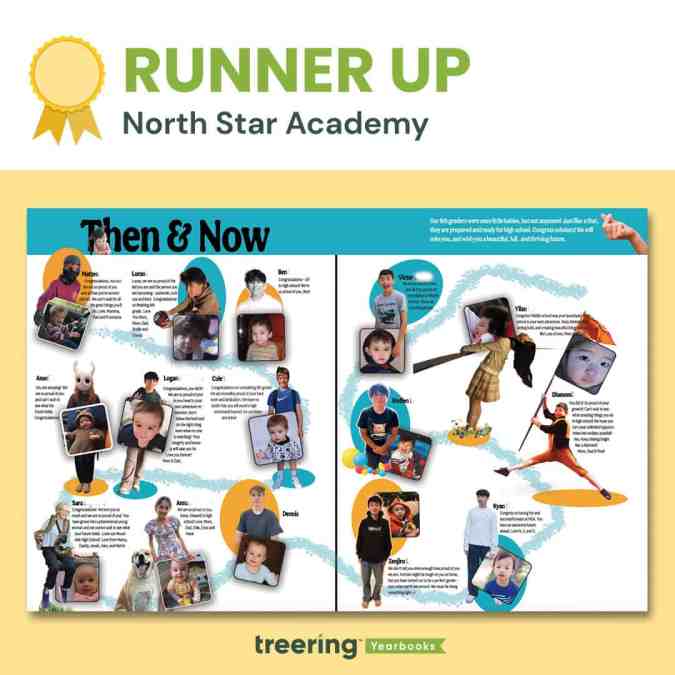
Finalist: North Star Academy, Redwood City, CA
Without seeing the entire book, you know there is a strong connection to theme: the aqua and goldenrod ovals and bold typeface are evidence of a solid style guide.
Adviser Carol Landers has a class of 30 students in grades 4-8 who help work on the book. She reserved this tribute to promoting students for herself.
Why we Loved this Design
Each eighth grader had their moment to shine with both a personality photo and a baby photo. Landers said parents contributed “photos of their students holding an object or pet or doing an activity that is important to [them].”
This highlights each student individually while using the promotion year 25 as the thread that connects them. Brilliant.
Landers employed a Google Form to solicit submissions from parents, and she’s planning ahead: “I just learned about Treering’s ‘secondary photo’ feature, so I look forward to trying that out next year.”
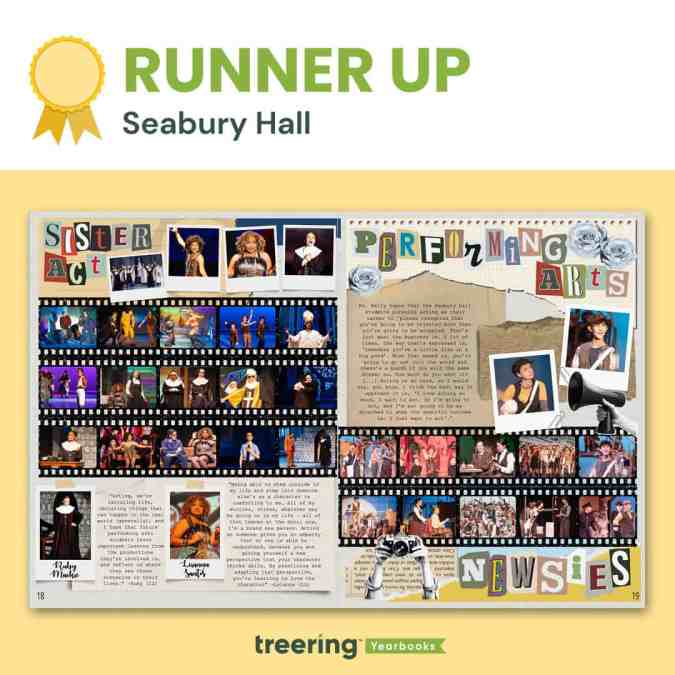
Finalist: Seabury Hall, Makawao, HI
“This spread is not just a collection of memories but a tribute to the dedication and creativity of Seabury Hall’s performing arts program,” designer Ethan Berry said, “preserving moments that will inspire future generations.”
Adviser Dakota Grossman is proud of Berry, a sophomore, who worked on this page solo. She said she helped in the brainstorming phase, and this is just one of his designs for Seabury Hall’s scrapbook-themed yearbook.
Why we Loved this Design:
Grossman said, “[Berry] truly paid attention to every detail—there's meaning behind every photo, graphic, and sentence on that page.”
That intentionality appears in the second, third, and fourth looks: beyond the colors, layers, and texture are student voices, photos of the cast in action, and a passionate narrative from the program director.
Visually, it is stunning. The narrative is compelling.
We wholeheartedly echo Grossman’s pride in Berry.
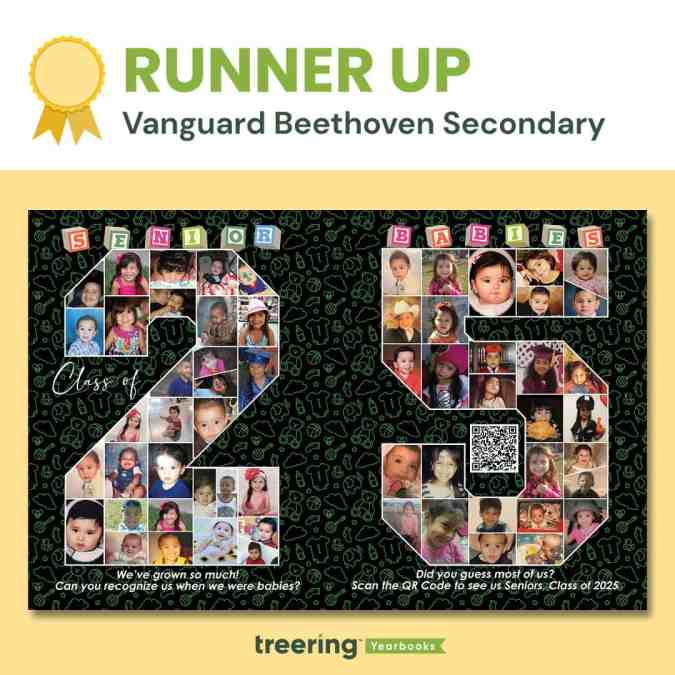
Finalist: Vanguard Beethoven Secondary, Pharr, TX
Bright, nostalgic, and playful, this spread is a showstopper. Baby photos capture the earliest moments of every senior’s journey, making this spread a heartfelt tribute.
Why we Loved this Design:
Aguilar’s vision is to blend a traditional yearbook with a multimedia presentation for the 58 seniors on their growing campus.
“The plan was to scatter all senior baby pictures,” Aguilar said. “I took it to the next level and created a media slideshow and have a QR [code] for everyone to view.”
It’s an elevated take on a yearbook classic. And we’re here for it.
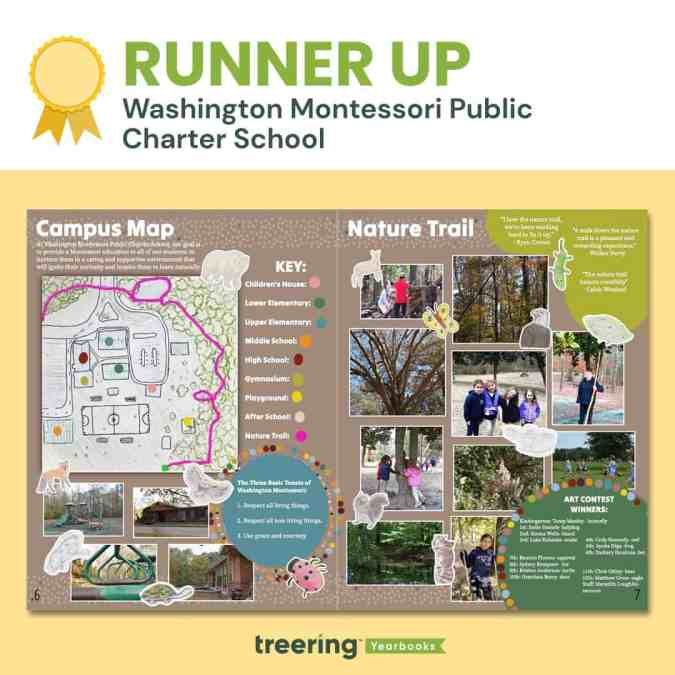
Finalist: Washington Montessori Public Charter School, Washington, NC
Senior Cadence Mallette’s creation could not go in any yearbook. This is uniquely WMPCS. She organized the yearbook team to capture student art, photos of the school and students interacting with their environment, student quotes, and a campus map. If that were a to-do list, it would look overwhelming.
Mallard made it work.
Why we Loved this Design:
We loved the mixed-media approach to this spread. Students in grades kindergarten through 11 submitted animals that share their habitat with WMPCS. Seniors drew the school mascot, a bald eagle. The winners made it on the spread.
Adviser Meredith Loughlin said this approach “united our yearbook group members while connecting them with our local ecosystem.”
This focus on unity also made it a winner. Sometimes, K-12 communities create separate upper and lower school content. Mallette’s design gives us a picture of whole-school approach.
Honorable Mentions
Because that’s not enough yearbook design inspiration, we want to call out these brilliant designs from elementary, middle, high, charter, and home schools.
Academy Days Co-op, Alliance Ouchi-O'Donovan 6-12 Complex, Alliance Renee and Meyer Luskin, Academy High School, Alma d'arte Charter High School, American Community School, Ancheta Academy, Assumption Catholic School, Atlanta Speech School - Stepping Stones, Atsa' Biya' A'ZH Community School, Auburn Hills Christian School, Avalon Middle School, Azle Christian School, Brush Middle School, Camas Connect Academy, Carencro High, CHESS Christian School, Chesterton Elementary School, City Garden School, Classical Conversations Folsom, Coconut Creek Elementary School, Cranberry Area High School, Cunha Intermediate School, Davis Intermediate School, Delhi High School, East Moline Early Learning Center, El Sobrante Christian School, El Tejon Middle School, Foothills Community Christian School, Fort Fairfield High School, Frank Bergman Elementary, Franklin Elementary School, Frederick Douglass High School, Frost ISD, Gate City Elementary, GEMS World Academy, Ghidotti Early College High School, Glencliff High School, Global Impact Academy, Global Impact Academy STEM High School, Heritage Christian School, Hilger Higher Learning, Hinsdale Elementary School, HomeWorks, HOPE Christian Academy, Indian Prairie Elementary School, John Glenn High School, Joyful Journey, Kennedy Middle School, Lakeside Christian School, Lakeside Elementary, Liberty Christian School, Maple Manor, Marfa, Marsh Grammar School, Martin J. Gottlieb Day School, Mary Morgan Elementary School, Maywood Center for Enriched Studies, Meiklejohn Elementary, Midland Elementary, Miraglia's Globetrotters, Mt. Everett Regional, NJWT New Jerusalem Worship Temple, North Bergen High School, O'Farrell Charter School, Options For Youth, Oxford Hills Comprehensive High School, Pinewood Intermediate, Pioneer Junior High, PRCES, Prune Hill Elementary, Quail Run Elementary, Rincon, University Marching Band, RISE HS, Rocky Mountain Classical Academy, Rocky Mountain Deaf School, Roseville Pathways, Ruth Batson Academy, Sacred Hearts School, Shatekon Elementary School, Shirley Hills Primary School, Smith Community Christian Co-Op, Soldier Hollow Charter School, Soldotna High School, South Orangetown Middle School, St. Jude Catholic School, Stratford Schools Fremont Boulevard, Stuart Paddock, Students On Academic Rise (S.O.A.R. High School), Swansea High Freshman Academy, Tandem Friends School, Tenor High School, Tenor High School | Cathedral Square Campus, TGU Granville, The Learning Connection (TLC), The Nova Center, Thomas J. McMahon Elementary School, Thomas Russell Middle School, Tri-County Homeschoolers, Victor H. Hexter Elementary, Vista del Mar, Wallace Elementary, Washington Middle School, Westlake Elementary, Westmont Jr. High School, Westside Global Awareness Magnet, Willett Elementary School

Yearbook photography laws: etiquette vs. legal rights
Have you ever wondered about yearbook photography laws and whether you can take pictures somewhere? Fun fact: photographing the Eiffel Tower is legal during the daytime, but things get more complicated at night. Learn what is okay and what's not in our list of photographers' rights.
Everyone has a camera in their pocket these days, don't they? It’s good to know that we can capture the moments that mean the most to us. But few of us think about or even know our rights or limitations in being able to do so.
I didn’t either until a store manager approached me one day. I was attempting to take a picture of my daughter and her friend in front of a display in the middle of the mall. The manager nicely explained that their store carries a stringent "no photography" rule and I would not be allowed to post my photo anywhere online.
I immediately complied with the manager for a few reasons. First, I didn’t consider it to be a big deal. It was just a posed photo - and I had taken a dozen more that day - so there was no importance to that particular shot. Also, I didn’t want to make more of a scene in front of the kids than had already occurred. And lastly, I needed to familiarize myself with yearbook photography laws and my rights as an amateur photographer.
To prevent finding yourself in a similar situation, read up on your rights to take and publish photographs. You can use this information to determine what is acceptable in your school's yearbook.
The laws
Not all "no photography" signs are clear, so always be on the lookout.
The general rule is that if you’re in a public place and can see it, you can shoot it. So, if you’re at the park or beach, whatever you see is open for photographing. Taking pictures on government property is mostly considered okay but prohibited on military bases and inside government buildings. (So, photos at the Washington Monument are fine, but taking pics inside your local courthouse isn’t.)
The line blurs a bit regarding what is called expected privacy. You’re not allowed to take pictures on public property if there is an expectation of privacy. For example, public restrooms are off-limits from photography. Similarly, taking photographs inside someone’s windows while standing on the sidewalk on public property is unacceptable.
When you’re on private property, the rules are more defined. The property owner can dictate what you are and aren’t able to photograph. You can be cited for trespassing if you do not adhere to these rules.
You can take pictures of strangers in public places without their consent. However, you cannot sell them without their knowledge or permission. For example, you can’t snap a picture of a stranger walking past you on the street and then sell it for profit as an advertisement to Coca-Cola. But, when you take a picture of someone at the science fair, publishing it in your yearbook is okay.
Err on the side of etiquette
Many public places like zoos and museums have photography rules posted directly on their website. But if you’re out on a school trip and can't find information about the photography regulations, ask someone who works there. Some locations allow and even encourage photography. Others allow photography as long as you don't use flash. Still others prohibit all photography, whether you intend to publish it or not. In the case of banned photography, management can ask you to leave the premises or, in extreme cases, have the authorities called. Again, save yourself the hassle and ask an employee.
When photographing other people, especially children, even though it’s legal to take their pictures in public, it’s still better –and more polite– to ask first.
At the beginning of the school year, students should receive a photography waiver for their parents to complete and return. This form allows families to decide whether their child’s photo can be taken and placed in school publications such as the yearbook. Make a list and keep it with you to avoid cross-referencing later.
The ACLU also recommends carrying this printable pocket guide of photographer’s rights with you in case someone approaches you despite being within your legal rights. Had I had such a document when that store manager spoke with me, I could have politely explained that malls are open to the public and I was within my rights.
Hassle-free yearbook publishing
Educating yourself on what is and isn’t acceptable in the world of yearbook photography laws can save you a lot of headaches when creating your yearbook. You’re already using Treering to make designing and publishing your yearbook easier, so following these simple rules will ensure you spend time on the fun aspects of yearbook creation rather than time-consuming hassles.
Are you still wondering what's up with the Eiffel Tower? The twinkle lights that come on at night are considered their own art installation and are still under copyright. Want the full coq au vin? Click ici.
Please note: this is not a legally binding guide. Photographers should always check the rules and regulations of all establishments and with parents before taking pictures.
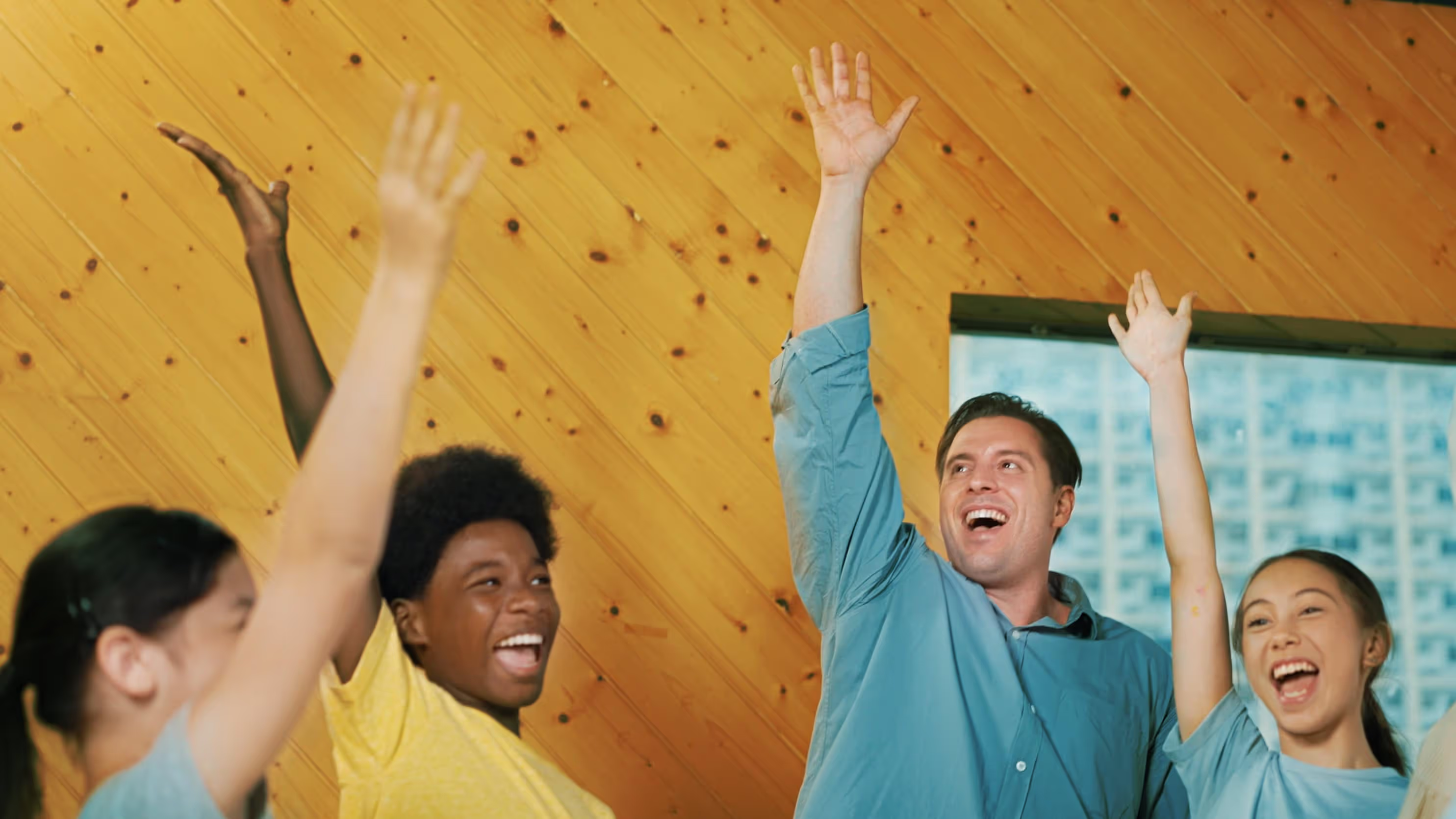
Teaching yearbook: game on
Camaraderie. Team work. Unity. Stress relief. Fun. These are just some benefits of adding games to your yearbook class. Balancing academics, extracurricular activities, and personal commitments can be demanding for students and advisers. Obvious statement: the yearbook production process adds a layer of responsibility. Playing games with your yearbook team early in the school year can be a way to break down walls. At the end of the year, playing games is a way to reconnect, rejuvenate, and review (because, if your district requires it, games can be a summative assessment.) Our curriculum team put together three games.
1. Off-limits, yearbook-style
This is the game of forbidden words. In teams, students try to get their teammates to guess the word on the card without saying the word itself or any of the off-limits words listed on the card. We created a mini-deck of 12 cards as a quick (and potentially loud) warm-up.
Rules
- Divide the group into two teams.
- Each team will alternate as the guessing and enforcing teams.
- In each round, one person from the guessing team will serve as the clue-giver. The clue-giver draws a card from the deck and tries to get their teammates to guess the word written on the top of the card. The clue-giver is not allowed to say the word itself or any of the “off-limits” words listed on the card.
- One member of the enforcing team will keep an eye on the “off-limits” words. If the clue-giver accidentally says an off-limits word (this includes variants) or phrase, the word is forfeited with no points awarded.
- Set a timer for each turn, typically 30-60 seconds, depending on age.
- When the guessing team correctly guesses a word, they earn a point.
- The game continues until all cards have been used. The team with the most points at the end wins the game.
Variations for play
- Project a card on the screen, and have the guesser stand in front while classmates deliver clues.
- Send a card via Team, Slack, Band, etc. and have team members comment with clues.
- Share a card on social and see if your followers know yearbook terminology.
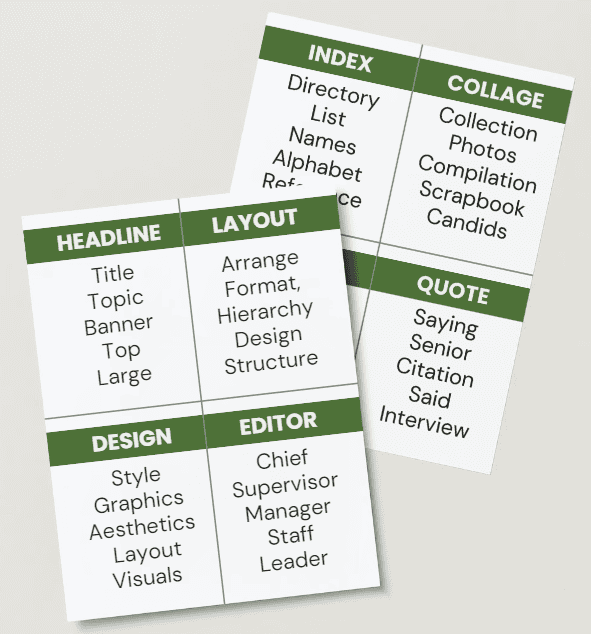
2. Sketch charades
Drawing and guessing go hand-in-hand in this guessing game. It challenges players' drawing skills and ability to interpret visual cues.
Rules
- Divide players into two teams. Each team selects a player to be the “artist” for their turn.
- At the start of each round, the artists draw one card.
- Without using any letters, numbers, gestures, or verbal clues, the artists sketch an image representing the word or phrase on the card. Both teams are guessing the same word.
- Set a timer for each round, typically 45-60 seconds, depending on age.
- If a team guesses the word correctly before time runs out, they earn a point.
- Rotate artists each round.
- The game continues until all cards have been used or until a predetermined point goal is reached. The team with the most points at the end wins the game.

3. Category countdown
Based on a classic party game, Category Countdown facilitates players to try to come up with unique words or phrases that fit specific categories in a hurry. Creative thinkers come up with some answers that push the limits–that’s why this is a crowd favorite.
Rules
- Display a category related to yearbooks.
- Set a timer for one minute, and have students take turns writing down items that fit within the category.
- When time is up, have a student read off their list. If no other student has the word, it’s one point.
- The student with the most unique answers after five rounds wins.
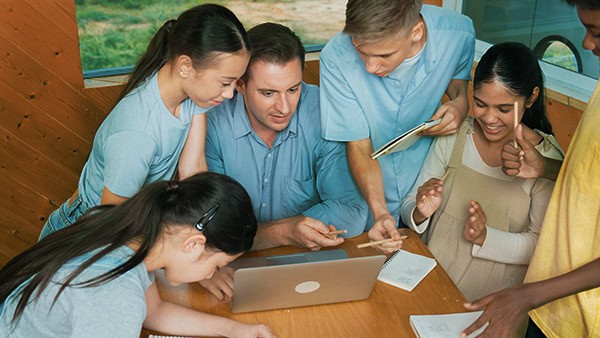
Variations for play
- In larger yearbook classes or clubs, break students into teams. One team can negate the others with duplicate words.
- Have students create a yearbook alphabet by brainstorming one answer per letter, A-Z.
- Use a random letter generator to limit responses to one letter.
Bonus: yearbook escape room
We created this yearbook freebie, which includes four puzzles that “unlock” the final clue. Yearbook advisers, use this print-and-go lesson for vocabulary review.
When you use these games for moments of shared fun, be sure to tag us on Facebook, Instagram, or TikTok when you share the videos.
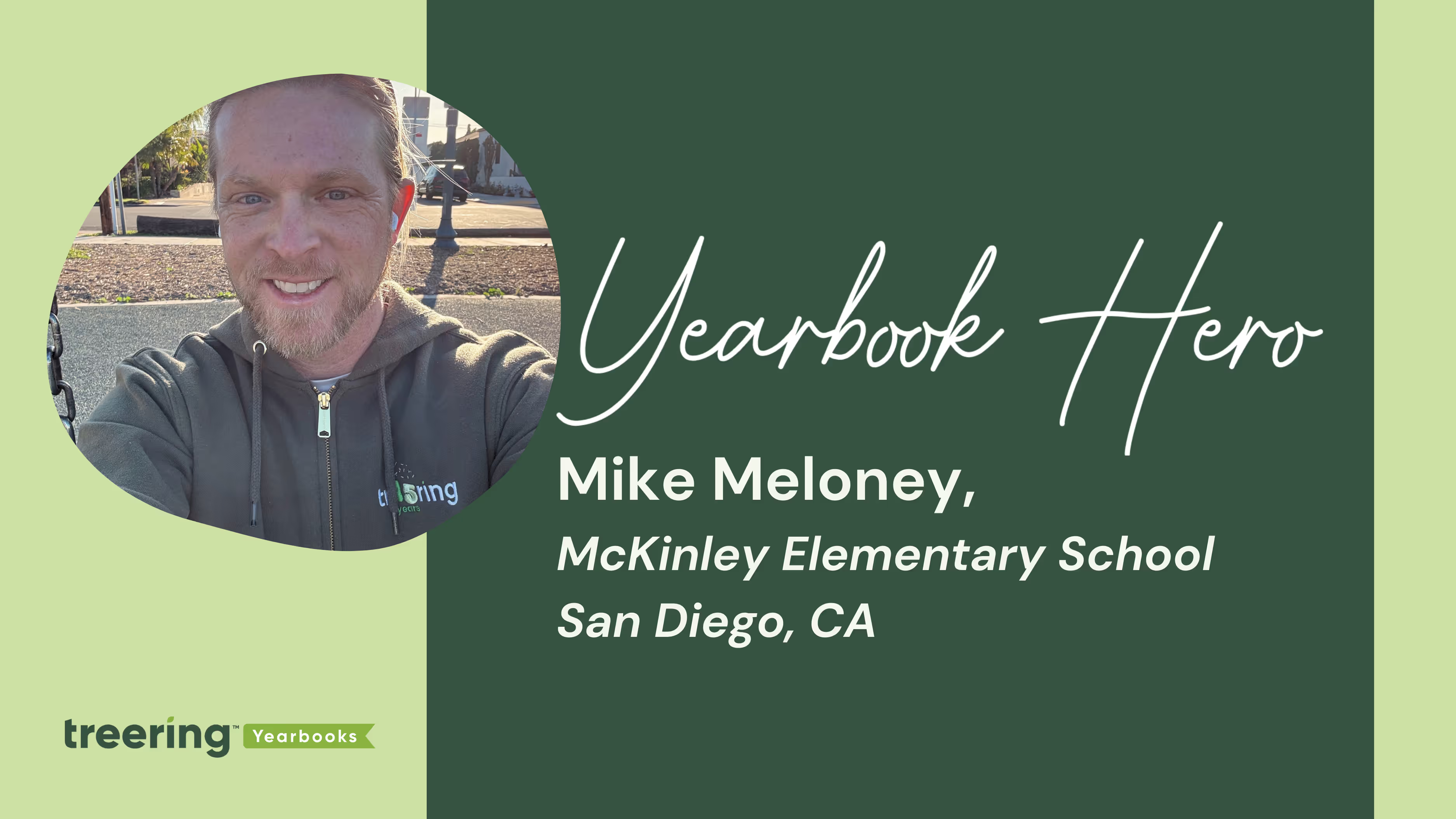
Yearbook Hero Mike Meloney didn’t have time to do the yearbook
Treering Yearbook Heroes is a monthly feature focusing on yearbook tips and tricks.
When Mike Meloney showed up to enroll his eldest son in kindergarten, the principal gave him a hero’s welcome because he was the school's yearbook coordinator. Except Meloney didn’t know he had the job.
How did you get "voluntold" to be the yearbook chair?
My sister works for Treering, and she was helping schools in San Diego make the switch from other publishers. When she called McKinley, Kristie not only sold them on Treering but also on me. She said it would be a great way to connect with the community and engage.
I told her I didn’t have time.
Four years later, you’re still doing the book. How did you help build a yearbook culture at McKinley?
I learned to get organized early. Even without photos, you can still do a ton of work on day one of school to make the rest of the year easier: label every page on the ladder and then make a shared Google folder for each page. Get those shared folders to every teacher, event coordinator, and committee involved. Send reminders once a month to share pics.
It's really been profound to go and take the photos, lay out the book, and help with the sales. When I show up, students say, "Hey, it's the yearbook guy."
Then, at the end of the year, when you give them out, and everyone's just googly-eyed about the year, they have this warm book in their hands. They sign it. It's just so special. And the memories that we make are—I hope—lifelong.
I have about five books left in me. My youngest is now in kindergarten.
What kinds of things do you do at the signing party?
It's all about reflection. One year, we had ice cream—as long as sugar's involved, kids are more engaged.
It's just a special time to be together, really reflect on the year, laugh, and share stories.
Custom pages are a big deal at our school. One person puts in 100, but many folks just do the two pages for free. The more I share about it, the more people get engaged.
At first, there's always the worry about the pages appearing in everyone's book. I tell them, “No, this is just your book that gets those pages.”
Once folks learn how easy it is to make them, they just go to town.
What do your kids think about being the ”yearbook guy?”
I have a unique connection with them and with the community. My kids are fully supportive. They're very critical at the same time. They'll come over and see the book-in-progress and say things like, “That doesn't go there” or “I don't like it.” And if I ever have a question about something, they just answer it.
So, in some sense, they're part of the committee.
What is something special you’re doing this year?
It’s the centennial year. The school opened in February 1925, and now, 100 years later, we're going from the Cougars to the original mascot, the Magpies. We also have an aerial drone shot of the kids lined up in the number 100.
The kids got together to research and interview some folks who were around in the school 60 years ago. They found these folks still living in the community, found old pictures, and made an exhibit.
Next month, there will be a centennial-themed scavenger hunt and, later, a variety show called “A Hundred Years of Stars.”
It’s a special year.
Any final thoughts?
You don’t need to carve out huge amounts of time to focus on making the yearbook, especially in the spring when there is a lot of content and you just have to layout pages. Do one to five pics while your kids are lackadaisical about getting their shoes on. Every moment in the Treering app is a chance to crop, zoom, and make it nice.

The history of the yearbook: how technology is reshaping it.
The history of the yearbook begins
We all know it’s a steadfast tradition in American schools, but what exactly is the history of the yearbook? According to a story by NPR, a Boston photographer named George Warren leveraged an advancement in photographic technology called the glass negative process to easily create many prints from one photograph. Warren encouraged his student subjects to purchase multiple portraits, share them with each other and then turn those collections of portraits into professionally bound books. The “Warren Yearbook” was born. The National Museum of History in Washington D.C. has the 1860 Rutgers College Yearbook on display, an example of a Warren Yearbook.
1900s and the printing press
The next big shift in the history of the yearbook came in the early 1900s with the invention and adoption of the printing press. Those books that were previously hand bound, one of a kind albums, could be mass produced with the creation of printing plates. Costs dropped, making the yearbook more accessible to schools and students from all walks of life. The stage was set for the growth of the traditional school yearbook
The computer age
Between 1985 and 2008 an explosion of technology brought on massive changes in the yearbook’s history, like desktop publishing, digital printing, social media and the widespread adoption of digital photography. The computer age disrupted almost every industry in the world including incremental improvements to the yearbook. Desktop software made it easier for schools to layout yearbook designs and digital photography provided a larger variety of shots from throughout the year.
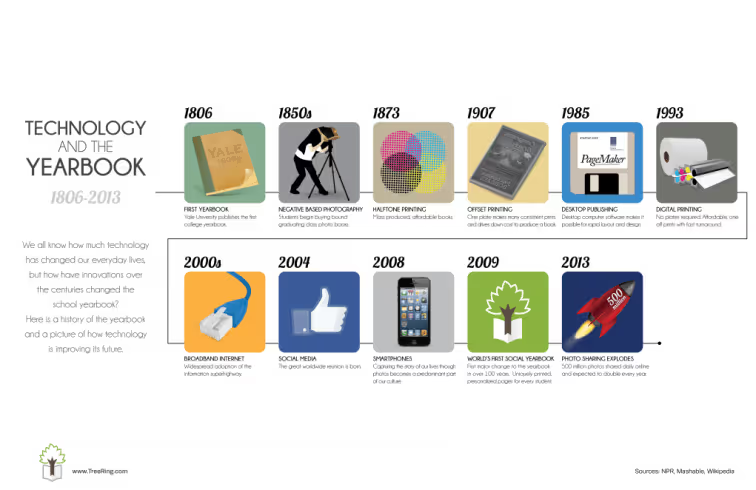
The social yearbook
In 2009, with the mass adoption of social media and its prevalence as a part of the American culture, the yearbook made its first major shift in over 100 years. Digital cameras and innovations in online software make it easy for students and parents to create their own memories and add them to their uniquely printed version of the yearbook.

10 Ways to relieve adviser burnout
It’s second semester, and we’re exhausted. Book fairs, grading, packing lunches, classroom celebrations, and family obligations are fantastic. We love them. They also wear us out. Layer the laudable task of gathering storytelling photos and husting the greatest yearbook your campus has yet to see, and it could be too much. If you're a team of one or two (or forty-two), yearbook adviser burnout is an especially strong possibility.
Treering staff member and yearbook mom Tevis D. said, “It’s okay to be not okay.” We just hope you don’t remain that way.
Remember your why
It’s a privilege to be entrusted with this task! It’s the opportunity to capture meaningful moments. The impact this year’s book will have cannot be measured now. It's not just about the visual elements, but also about the sounds of laughter captured in photos, the feel of the pages as you flip through them, the scent of freshly printed paper, and the breath of satisfaction as you see the finished product.
1. Express appreciation
Recognize and appreciate the efforts of your volunteers and the people on campus who champion your yearbook program. We know gratitude changes attitudes. It’s a great way to rejuvenate.
2. Recognize yearbook milestones
Celebrate throughout the yearbook production process to boost morale and maintain momentum. Upload your roster and toast yourself with a latte. Create a ladder with the team, then go out for pizza. Other steps to consider:
- Every x spreads marked complete
- Selling 25-50-100 yearbooks
- Having all the sports team photos complete by a certain date
Sometimes, a celebration can be as simple as a hat day or a classroom dance party. (Even high schoolers like a throwback GoNoodle video.)
3. Practice mindfulness
Incorporate mindfulness exercises into your routine to reduce stress, increase focus, and maintain a sense of perspective and balance. Schedule regular breaks during yearbook production to rest, recharge, and prevent burnout.
Ask for help… and get It!
If you’re creating the yearbook solo (or just feel like it), help is available.
4. Use your publisher
Treering Customer Success Manager Liz T. tells advisers, “If it is stressing you out—and yearbook related—contact me.”
If you’re not a Treering editor, what are you waiting for? call your publisher and tell them you are at a standstill. They should have resources and training to help you move forward and create a workflow to simplify your process.
Newer to the yearbook game, you may not yet know what you don’t know, so it helps to follow a plan. Here are two popular ways to tackle a yearbook project:
5. Create a support network
Reach out to fellow advisers in your district, journalism mentors, or your publisher for guidance, advice, and support. Bring in experts as guest speakers to do some teaching for you: utilize your area journalists, alumni yearbook students, or even the Team Treering.
Strengthen your workflow
You can release stress from your mind by systematically addressing and resolving challenges in your yearbook project. It's about taking a methodical approach to problem-solving, allowing yourself to let go of stress, and approaching each task with renewed focus and energy. Remember: you don’t have to do it all at once!
6. Chunk your work
Breaking it down is more than a call to action on the dance floor: it’s a project management technique.
Here are some tips from the Treering staff:
Yearbook Specialist Karen B. said, “I like to stay on top of my pics and layouts: right after the event, I create the spread. This way, I'm never buried in spreads from October when it's January. And on slow event months, I catch up on other spreads.”
Yearbook Specialist Ali J. gives herself a cushion with her public deadline (yearbook purchases and custom pages). “As an elementary school advisor, I always set the deadline earlier than needed for parents to submit, then added a few days for the procrastinators (mostly for me),” she said.
The lone yearbooker
Identify and prioritize the most important tasks, focusing on those that contribute most significantly to the yearbook's quality. Typically, this encompasses your ladder, school portraits, and candid photos.
Some easy ways to simplify your workflow from Yearbook Specialist Kate H. include:
- Re-using layouts from previous years and changing out the headlines and captions
- Copy portrait settings from one class to the next
- Create photo and text styles
- Use pre-made page designs or templates
“One of the hardest things for editors to do is get content. Without it, you don’t have a book,” said Customer Success Manager Jason S. He helps advisers set up a system to collect photos from homeroom teachers.
Remember, saying no to additional responsibilities or requests that may overwhelm you is OK.
Managing a class or club
After you break down the yearbook project into smaller tasks, distribute them to your team. This way, there are no surprises on who is expected to cover what.
General tasks to delegate include:
- Photo management: uploading, crowdsourcing, tagging, selection
- Layout selection: templates, style guide
- Interviews: questions, scheduling
- Sections: people, athletics, student life, reference
- Copy editing and proofreading
7. Set clear expectations
We all need to clearly communicate roles, responsibilities, and expectations to volunteers, staff, and students from the beginning. The same goes for ourselves.
Think about the tasks you'll need to oversee, such as organizing photo assignments, designing layouts, and marketing the yearbook. (And remember, using Treering means we handle payment processing, yearbook sorting, and order tracking. Phew!)
8. Receive (and share) ongoing training
Find training sessions and shareable resources for inspiration or to fill in knowledge gaps. It may seem counterintuitive to add something when you’re feeling overwhelmed. Sometimes, an outside force (hello, inertia) is the change we need to pivot in a more positive direction. Our go-tos include:
If you are part of a class, club, or committee, use these opportunities to up your skillset as team building. Oreos also help.
9. Use automations
Embrace the ways tech can help increase efficiency. Treering’s software helps you create polished layout effortlessly by
- Auto-flowing portraits from any photographer
- Laying out your photos in a professionally design yearbook spread
We tossed the orange wax pencils and scaleograph for a reason!
10. Addition by subtraction
Sometimes, to move forward, we have to take a page from the Oregon Trail playbook: jettison what’s holding you back and keep moving forward.
These strategies can help you navigate the challenges of yearbook advising while staying motivated, resilient, and passionate about your role as a memory-maker and historical record preserver. Say no to adviser burnout and yes to another great year(book)!

